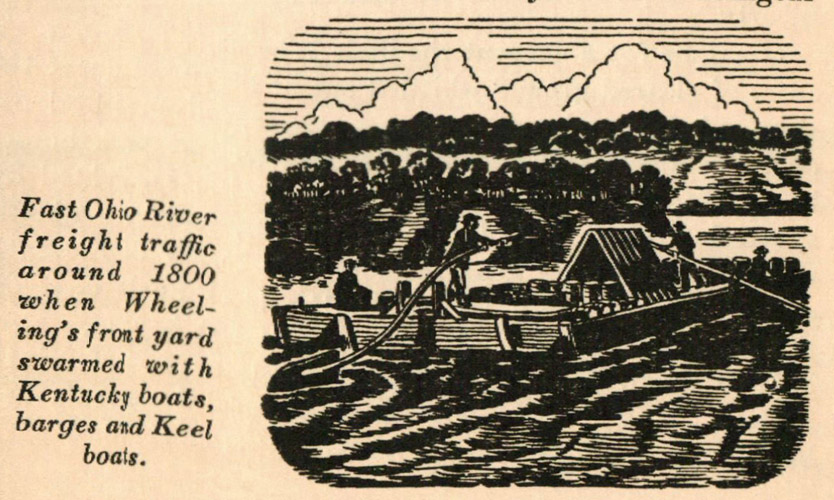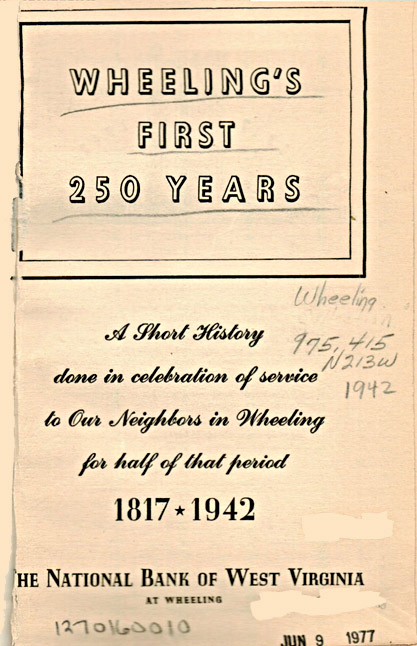Wheeling's First 250 Years
|
nnnn This small document was recommended by Margaret Brennen as |
p 16-17
men under Colonel David Shepherd, first Ohio County Lieutenant, helped General Brodhead smash the Indians at I Coshocton in 1781. That July, Clark was off down the! river again; Colonel Lochry's tragic expedition lost a third of its troops near Cincinnati. Fort Henry repulsed another attack on August 24; the Zanes and their neighbors lost their houses a second time. Cornwallis surrendered at Yorktown on October 19 but the western frontiers kept on fighting. Settlers still lived in constant terror of both British and Indians.
Wheeling patriots shared the defeat of Colonel Craw ford's unfortunate army that started out bravely from the Mingo bottoms the next May, 1782. McColloch was killed while out scouting in July. The British launched two final expeditions from Detroit, one of which brought 400 regulars and Indians again to the impregnable gates of Fort Henry. Colonel Zane commanded the beleaguered villagers and 5 militiamen who held off the attackers from September 11 to 13, 1782. It was during this last battle of the Revolutionary War that heroine Elizabcth Zane ran to the Zane home and brought back the gunpowder sorely needed by the defenders.
4. Wheeling Begins To Grow Up
Back in those colonial days news traveled no faster than horses. Imagine a world without such modern common places as steamboats, railroads, automobiles, airplanes, telegraph, telephone, radio. But the Virginia Gazette printed the news of Concord and Lexington on April 29, 1775, only 10 days late; and in 12 days more it was being discussed excitedly in the cabins in Wheeling. Pioneer travelers carried it on foot, on horseback, in canoes, far more of them going through the Zanes' little settlement than ever stopped there. Even with their increasing traffic, it was 1790 before all Ohio County could boast of 5,212 inhabitants. They got no legal titles to their 400-acre pieces of land, except by Tomahawk or Settlement Rights, before 1779.
In spite of the war and the Indian dangers, they built their rough houses cleared land, planted and began estab lishing a ~orl}llll c~mmunity life. First Ohio County court was held lJ1 1777 at Black's Cabin on Short Creek, soon to be called West Liberty. The first will was ?led that year.
It was no place for weaklings. While having families of 12 to 15 children, the women helped in the clearing, sat at their spinning wheels by candle light, made theIr own linsey-woolsey dresses. There was little money, food was plain and often scarce but visitors were always welcome to share it.
Ebenezer Zane cleared 10 acres along the now Main and Market Streets between the brow of the hill and the Suspension bridge. Later he would tackle the Island which was part of his claim. The second of his 18 children, Noah, who was born October 1 1775, was destined to become the first president of Thee Northwestern Bank of Virginia. Colonel David Shepherd was sent by his neighbors to the Virginia legislature in 1784. Next year [1785] Virginia and Pennsylvania Settled their boundary dispute; Rev. Wilson Lee held the first Methodist church service in Wheeling. Mail post routes got as far as Pittsburgh in 1786. A year later [1787, out-growing Wheeling, West Liberty was establish~ the first town in Ohio County. In 1788 Absalom Martin founded Martins Ferry.

Following the flood of 1789, the Zanes began operating the first ferry on the Ohio River. Next year John McIngtur and Sarah Zane took out the first marriage license in the county. There was a serious threat of famine among the settlers. An Indian uprising in 1791 climaxed in a fierce battle just across the river at Fort Kirkwood, site of Bridgeport. It was during this tragic period that the four Crow sisters, venturing a mile from their home on big Wheeling Creek, were seized by Indians and a renegade white. One of the girls broke away and ran home for help but when the rescue party found the others next morning two were dead, the third was dying.
5. Wheeling Enters the Nineteenth Century
Wheeling was growing faster as 1800 approached, aided by the quickening flood of pioneers pouring through to the West. In 1795 when the village became a town, Jacob Gooding put up its first brick building, an inn where the Windsor Hotel now stands. In 1797 they moved the County Seat from West Liberty to Wheeling, held first court here in Gooding's Inn a year later [1798], before the erection of the first Court House, on present Tenth Street between Main and Market. Last year of the century [1799] came Noah Linsly from Connecticut, Yale graduate, attorney, to practice law in the thriving river town and leave a fortune to found Linsly Institute, a free school for poor white children. In 1800 the first school in Ohio County was opened near West Liberty.
Imagine for a moment the little Wheeling of 1800, a few acres of cleared ground whittled out of the forest above the river. A few mud roads, not yet streets, enlivened by loose domestic animals and emigrants' wagons and pack horses headed for the ferry. A few dozen log houses, lighted by sputtering pitch pine knots or candles, scattered about Colonel Zane's home near the southeast corner of Eleventh and Main Streets, Fort Henry half a block north of it on the river side of Main, a burial ground just beyond. Keel boats tied up down along the river at the end of Ninth Street. A few hundred inhabitants; colonial dress replacing backwoods costumes; simple frontier diets embellished with wild golden rod and sassafras tea, parched corn and barley, honey, home-made maple syrup. Gooding's Inn the gathering place from the village darkness. The first circus which brought an elephant and a camel in 1801 was axxxdous event.
TIHhe busy half-primitive Wheeling Dr. Francois Andre aux, celebrated French naturalist, found when ,
.lu- villil in 1802, arriving over the newly repaired road ;fJ'()1I1 l\lOtown. Dr. Gideon Forsythe became the first :Io('nl (lian a year later. In 1804 Noah Linsly was ILppnilllrst commonwealth attorney and Virginia :g 1'1111 I «first bank charter to the Bank of Virginia. By ; I HOI) (,LUt traffic was making Wheeling a boom town; I1lor(' 1.]00 wagons and carts crossed the Ohio River in I !tn'(' ns that spring that saw notorious Aaron Burr ,
Ii nil Ilhnerhassett Island. Next year Wheeling was
incorporated as a town, elected George Miller its first
,
mayor, and erected a 20-foot square market house of logs on
, I ht· ('Ill given to it by Noah Zane. William McConnell built the second brick house.
Bul sensational news of 1806 was the decision of : ('()lIgnbuild a national road from Cumberland west to . I he Oliver. It was George Washington's idea but President Jefferson signed the act. It was to follow Bradock’s through Uniontown and Brownsville; local ex ; (·il(·l1u'n mixed with consternation when there was talk (If Il pe selection of Wellsburg as the river terminus!
p 20-21:
